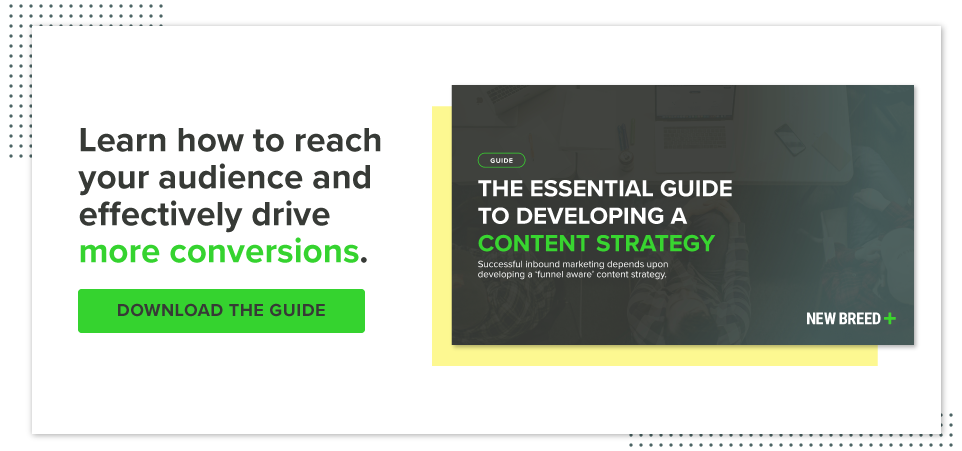The Key Steps Your Content Creation Framework Should Include

Creating content isn’t as simple as sitting down, saying you’re going to produce something and then doing it. It requires initial brainstorming so you can determine what you’re creating and how it relates to the rest of your strategy. Then the creation process can require multiple rounds of revisions as you work to ensure your finished content meets its intended goal. Next, you need to send your content live and promote it.
“Content is ever-present. It’s going to be part of your business no matter what,” says Guido Bartolacci, New Breed’s Head of Demand Generation.
Content is a vital part of your marketing efforts, and it can also be used for sales enablement, customer engagement, customer support and even internal training.
While some pieces of content can be created as they become needed, marketing content, like blogs, needs to be produced on a consistent schedule in order to be most effective. Without a content creation framework, it’s difficult to hold yourself accountable to producing content at your desired cadence.
A content creation framework is a plan consisting of what steps need to be taken, how long each step will take and who’s responsible for completing each step.
Step 0: Plan Your Content Strategy
How frequently do you want to produce blogs, long-form content offers, videos and the other pieces of content? This will inform the rest of your efforts.
Once you know how much total content you want to create, you can calculate how much time you have to work on each asset. For example, if you want to publish four long-form content offers each year, then you have at least three months to work on each one. Meanwhile, if you want to publish two blog posts a week, you either have two to three days to create each one or you’ll need to work on multiple posts simultaneously.
Step 1: Topic Ideation
To determine what topics you write about, you can start with keyword research, you can identify gaps in your existing content or you can gain inspiration from new trends within your industry that you want to share your expertise on.
If you have a yearly content creation goal, you don’t necessarily need to plan the entire year at the same time, but you should be pre-planning on a periodic basis. At New Breed, we break our blog planning into four-week sprints.
“For keyword research, we create a list of 20 keywords that we want to rank for every 4 weeks,” Guido says. “That list is put together through a combination of what we want to rank for, what we currently rank for and where there’s currently opportunities to rank.”
Then, we use those keywords to inspire ideas for blog posts.
Developing ideas based on content gaps or thought leadership happens much more organically. You can’t necessarily set a recurring meeting to come up with them. Instead, it’s important to have a process for documenting those ideas when they come up.
For example, at New Breed, we have a tab in our blog editorial calendar called “topic ideas” for that purpose. Then, when we meet once a month to finalize our planned content, we pull from both the topic ideas and the keywords we identified to fully develop our editorial calendar.
Step 2: Assign People to Responsibilities for Each Step
Every piece of content you create will require a subject matter expert, a writer, an editor and a publisher. While you can have one person fulfill multiple roles, you should at least have two individuals working on each piece so that there are checks and balances in place.
- The subject matter expert is the technical expert or thought leader on a given topic. If they’re not writing the content, they’re typically interviewed by the writer. Long-form content offers might have multiple subject matter experts involved
- The writer is the person who drafts the content, though they may not always be listed as the author
- The editor acts as quality control, providing a second set of eyes on the content. Ideally, you’d have multiple editors to help with different types of edits, but this can just be one person on a smaller team
- The publisher will flow the finished content into your CMS and set up landing pages when necessary. They’ll also optimize your content for organic search
Knowing who’s responsible for each role will help you determine how much time to allot for each task. For example, if you have a team devoted to creating blog content, then you can give them shorter windows to accomplish each task than if team members are just helping with the blog as a side project.
Based on the topics you’ve selected, you can choose the best-fit people on your team to fill these various roles for each post. Notify everyone involved as early as possible and document their responsibilities in place they can easily access, like a shared calendar or project management tool.
Step 3: Create the Content
In order to create any content, you first need to collect all the information you’ll need for it. If the writer is the subject matter expert, this involves conducting research to find data to support their points. If the writer isn’t the subject matter expert, they’ll need to interview someone with technical expertise in addition to conducting research.
Once all the necessary information has been collected, the writer can start drafting the content.
Step 4: Edit
Even the best writer will make mistakes in their draft, and once you overlook a mistake once, it’s next to impossible to catch it later on. So, once a draft is complete, it needs to be edited by someone else.
There are multiples types of editing that can take place:
- Development editing involves taking a big-picture look at the content in its entirety and determining whether it contains all the necessary information and is properly targeted to your audience. This process can involve restructuring the post or requiring the writer to make substantial changes
- Line editing focuses on optimizing content at the sentence level. It can involve improving some grammar and punctuation but primarily looks at improving the language used throughout the post and ensuring the voice and tone is consistent.
- Copyediting aims to remove all errors from a post, whether those are grammatical and punctuation mistakes or inconsistent stylings of titles or compounds.
For a smaller piece of content, like a blog, these can all be combined into one step if you don’t have the time or resources to do them all separately.
Step 5: Publish and Promote
Once a piece of content is polished up, it’s time to publish it and share it with the world. For a blog, this means flowing it into your CMS.
“We recommend having someone take a look at the post with an SEO lens to make sure that even if it’s not necessarily intended to rank, it is SEO-friendly and is as optimized as it can be for search,” Guido says. “And, it’s always helpful to have that last set of eyes to maybe tweak the title a little bit, add some links, change the meta description and make sure certain keywords are included in the post.”
In addition to the SEO benefits, the publish task is also an opportunity to get one final read-through for quality.
Once your content is live, you should also promote it across your channels. Share it on social media, send out an email to relevant contacts and consider doing paid promotion when relevant.
Step 6: Optimize the Process Itself
Finally, it’s important to periodically take a step back and analyze your content creation framework itself.
Have all the steps been followed as planned? Are there areas that need more or less time devoted to them? Can you create more content? Do you need to create less? Are you actually achieving your goal? Are all team members following the process as it’s laid out?
Your framework shouldn’t be set in stone. As you gain experience creating content or as your team grows, your process will need to adapt accordingly.
The Takeaway
Throughout the entire content creation process, it’s important to hold everyone accountable to finishing their tasks on time, because one delay can throw off every remaining step.
Additionally, you might have different content creation frameworks for different content formats. For example, a press release will require more edit and review steps than a blog. A long-form content offer might have an outline stage before it gets drafted, plus a design step as part of the publishing process.
In general though, creating a content creation framework and then sticking to it will help you stay accountable for producing your desired amount of content and be more consistent in the quality of the content you produce.
Quinn Kanner
Quinn is a writer and copyeditor whose work ranges from journalism to travel writing to inbound marketing content.





